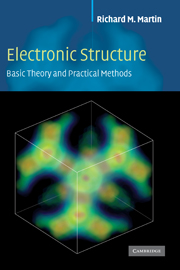Book contents
- Frontmatter
- Contents
- Preface
- Acknowledgments
- Notation
- Part I Overview and background topics
- Part II Density functional theory
- Part III Important preliminaries on atoms
- Part IV Determination of electronic structure: the three basic methods
- Part V Predicting properties of matter from electronic structure – recent developments
- 18 Quantum molecular dynamics (QMD)
- 19 Response functions: phonons, magnons, …
- 20 Excitation spectra and optical properties
- 21 Wannier functions
- 22 Polarization, localization, and Berry's phases
- 23 Locality and linear scaling O(N) methods
- 24 Where to find more
- Appendix A Functional equations
- Appendix B LSDA and GGA functionals
- Appendix C Adiabatic approximation
- Appendix D Response functions and Green's functions
- Appendix E Dielectric functions and optical properties
- Appendix F Coulomb interactions in extended systems
- Appendix G Stress from electronic structure
- Appendix H Energy and stress densities
- Appendix I Alternative force expressions
- Appendix J Scattering and phase shifts
- Appendix K Useful relations and formulas
- Appendix L Numerical methods
- Appendix M Iterative methods in electronic structure
- Appendix N Code for empirical pseudopotential and tight-binding
- Appendix O Units and conversion factors
- References
- Index
22 - Polarization, localization, and Berry's phases
from Part V - Predicting properties of matter from electronic structure – recent developments
Published online by Cambridge University Press: 05 June 2012
- Frontmatter
- Contents
- Preface
- Acknowledgments
- Notation
- Part I Overview and background topics
- Part II Density functional theory
- Part III Important preliminaries on atoms
- Part IV Determination of electronic structure: the three basic methods
- Part V Predicting properties of matter from electronic structure – recent developments
- 18 Quantum molecular dynamics (QMD)
- 19 Response functions: phonons, magnons, …
- 20 Excitation spectra and optical properties
- 21 Wannier functions
- 22 Polarization, localization, and Berry's phases
- 23 Locality and linear scaling O(N) methods
- 24 Where to find more
- Appendix A Functional equations
- Appendix B LSDA and GGA functionals
- Appendix C Adiabatic approximation
- Appendix D Response functions and Green's functions
- Appendix E Dielectric functions and optical properties
- Appendix F Coulomb interactions in extended systems
- Appendix G Stress from electronic structure
- Appendix H Energy and stress densities
- Appendix I Alternative force expressions
- Appendix J Scattering and phase shifts
- Appendix K Useful relations and formulas
- Appendix L Numerical methods
- Appendix M Iterative methods in electronic structure
- Appendix N Code for empirical pseudopotential and tight-binding
- Appendix O Units and conversion factors
- References
- Index
Summary
Summary
Electric polarization is one of the basic quantities in physics, essential to the theory of dielectrics, effective charges in lattice dynamics, piezoelectricity, ferroelectricity, and other phenomena. However, descriptions in widely used texts are often based upon oversimplified models that are misleading or incorrect. The basic problem is that the expression for a dipole moment is ill defined in an extended system, and there is no unique way to find the moment as a sum of dipoles by “cutting” the charge density into finite regions. For extended matter such as crystals, a theory of polarization formulated directly in terms of the quantum mechanical wavefunction of the electrons has only recently been derived, with an elegant formulation in terms of a Berry's phase and alternative expressions using Wannier functions. The other essential property of insulators is “localization” of the electrons. Although the concept of localization is well known, recent theoretical advances have provided new quantitative approaches and demonstrated that localization is directly measurable by optical experiments. This chapter is closely related to Ch. 21 on Wannier functions, in particular to the gauge-invariant center of mass and contribution to the spread of Wannier functions ΩI of Sec. 21.3.
The theory of electrodynamics of matter [448, 790] (see App. E) is cast in terms of electric fields E(r, t) and currents j(r′, t′). (Here we ignore response to magnetic fields.) In metals, there are real currents and, in the static limit, electrons flow to screen all macroscopic electric fields.
- Type
- Chapter
- Information
- Electronic StructureBasic Theory and Practical Methods, pp. 434 - 449Publisher: Cambridge University PressPrint publication year: 2004



